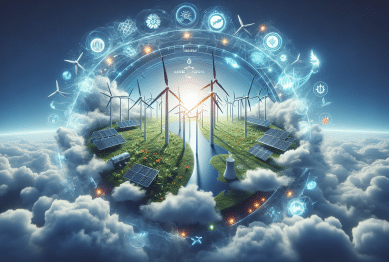The green revolution in technology is no longer a quiet movement—it’s an all-out sprint. Climate tech startups are stepping up with bold, scientifically driven, and business-savvy solutions that are capturing the attention of investors, global policymakers, and everyday people alike. From tackling data-center energy demands to reinventing textiles and exploring uncharted carbon capture techniques, these startups aren’t just innovating—they’re reshaping how industries think about sustainability.
This article explores the most exciting emerging trends and startups leading the charge in 2025, backed by credible and recent reports.

Investment Realities: Momentum, Realism, and Selective Optimism
Despite frequent headlines about funding slowdowns, climate tech remains a powerful draw for investors. In early 2025, venture funding in climate startups reached around $10 billion, which was roughly half of the previous year’s total during the same period. While that sounds like a steep drop, context matters. Globally, venture capital across nearly all sectors has tightened, yet climate innovation continues to capture one of the largest shares of early-stage financing.
The difference in 2025 is focus. Investors are exercising more selectivity, emphasizing measurable results, strong business models, and scalability. Areas attracting particular attention include carbon capture, sustainable agriculture, circular materials, and renewable infrastructure. This trend toward selective optimism suggests the industry is maturing, moving away from hype-driven investments toward ventures with credible paths to impact and profitability.
Trend Spotlight: Data Centers — The Unexpected Battlefield
The rapid growth of artificial intelligence has thrust data centers into the climate spotlight. These massive facilities already consume about 1–2 percent of the world’s electricity, and projections suggest that figure could nearly double by the end of the decade. That reality presents both a problem and an opportunity.
Climate tech startups are innovating with solutions that make data centers greener and more efficient. From modular power electronics to on-site clean energy storage, companies are working to reduce the sector’s carbon intensity. Emerging technologies in hydrogen fuel and advanced battery systems are also being tested as ways to cut reliance on fossil fuels.
For startups, data centers represent a new proving ground. These facilities have clear demand for cleaner, more resilient energy systems. At the same time, climate tech innovators gain a revenue source that accelerates decarbonization while strengthening the backbone of the digital economy.
Ocean Carbon Capture—Promise Meets Skepticism
Another frontier gaining attention in 2025 is ocean-based carbon capture. Startups are experimenting with methods that encourage algae growth, which in turn captures carbon dioxide as the algae sink to the ocean floor. Some companies have already begun selling carbon credits based on this approach and striking deals with industries like aviation that need credible offset solutions.
Yet this area has sparked significant debate. While the potential to sequester carbon for centuries is attractive, scientists warn of unknown ecological consequences. Concerns about transparency, monitoring, and unintended side effects—such as disrupting marine ecosystems—make investors and regulators cautious.
The lesson here is clear: bold ideas need rigorous scientific backing. Ocean-based carbon capture may one day become a powerful tool, but in 2025 it remains a space defined by both promise and skepticism.
Recycled Carbon Chemistry: Turning Pollution into Products
If capturing carbon is one challenge, transforming it into something useful is another. A new generation of startups is pursuing exactly that, with some early wins to showcase.
One French-American startup, for instance, has developed technology that uses an electrolyzer to convert carbon dioxide, water, and electricity into ethylene. Ethylene is a foundational ingredient for plastics and countless industrial products, meaning this process has the potential to transform emissions into valuable building blocks. With millions already raised in funding and prototype systems in place, these ventures are showing that pollution can be reimagined as a resource.
Such approaches could help close the loop on carbon emissions by tying them directly into industrial supply chains, creating both environmental and commercial value.
Green Materials & Textiles: Fashion’s Eco Makeover
The fashion industry has long been criticized for its environmental impact, from water-intensive cotton cultivation to chemical-heavy dye processes. Climate tech startups are now stepping in to reimagine how fabrics are produced and recycled.
One company has drawn attention for its ability to transform pre-consumer textile waste into a luxury fiber. This fiber is designed to integrate seamlessly into existing manufacturing systems, which is key for adoption by major brands. After years of development, the startup secured significant seed funding and is now piloting its material with top fashion houses.
If successful, this innovation could provide an alternative to cashmere and other environmentally damaging fibers, reducing both land degradation and waste. The example highlights how startups are weaving sustainability directly into consumer products without sacrificing performance or aesthetics.
Early-Stage Success: Europe’s Sustainable Startup Stars
Europe has become a hotbed of climate innovation, with a growing number of startups gaining recognition for their pioneering work. A recent ranking of emerging companies pointed to several standouts:
- A microplastic removal startup that has already secured several million euros in funding.
- A textile biofabrication company developing fabrics with microorganisms, attracting investment and industry partnerships.
- A sustainable fabric manufacturer offering alternatives to synthetics and gaining traction with fashion designers.
- A renewable energy management platform that helps households and businesses track and optimize usage.
- A hydrogen generator startup using methanol reforming as an innovative energy solution.
Beyond these, other European companies are tackling everything from nanosatellite-based connectivity for climate monitoring to compostable packaging solutions. The diversity of approaches illustrates how Europe is cultivating a resilient ecosystem of climate solutions that go far beyond traditional energy and agriculture.
Funding Amid Flux: Rising Funds in a Tough Climate
Even as funding totals dip globally, new venture funds are entering the market with dedicated climate strategies. In 2025, a New York-based firm closed a 54 million dollars first-time fund aimed specifically at seed-stage climate startups. Backed by prominent technology leaders and institutional partners, the fund will target sectors such as food systems, land use, manufacturing, and climate adaptation.
This reflects an important shift: while investors may be more cautious with checks, there is still a strong appetite for well-positioned startups addressing urgent climate challenges. For founders, the path forward may involve aligning with these new, specialized funds that understand the long-term value of climate innovation.
What’s Next? Innovation, Policy, and Ecosystems
The future of climate tech rests on a few key pillars.
1. Smart Policy and Incentives
Governments remain critical players. Policies like the European Green Deal and the U.S. Inflation Reduction Act continue to drive innovation by offering incentives, subsidies, and frameworks for adoption. Startups that align with these programs can gain a decisive advantage.
2. Cross-Sector Partnerships
Climate tech startups rarely succeed in isolation. Partnerships with established corporations can accelerate adoption, whether through integrating sustainable fibers into luxury fashion or powering data centers with geothermal energy. These collaborations combine agility with scale.
3. Integrated Technology Solutions
The most powerful innovations are increasingly interdisciplinary. Artificial intelligence is being combined with energy optimization, materials science is merging with circular design, and agriculture is intersecting with data analytics. This fusion of disciplines is where the next wave of breakthroughs will emerge.
Final Thoughts: The Role of Climate Tech Startups
In 2025, climate tech startups are proving they’re about more than ambitious promises. They are merging science, business, and narrative to deliver practical climate solutions at scale. From sustainable textiles to recycled carbon chemistry, from powering greener data centers to experimenting with new forms of carbon capture, each innovation contributes to a broader movement: reshaping the global economy toward sustainability and for entrepreneurs, it shows a path where innovation and impact can walk hand in hand.
The green revolution is increasingly entrepreneurial, diverse, and dynamic. If current momentum holds, 2025 may be remembered as a defining year in the rise of climate tech startups.
References
- Associated Press. (2025, May 22). Israeli startup Gigablue touts ocean carbon capture, but scientists urge caution. Available at: https://apnews.com (Accessed: 20 August 2025).
- Vogue Business. (2025, June 3). This startup says it has the answer to cashmere’s sustainability problem. Available at: https://www.voguebusiness.com (Accessed: 20 August 2025).
- Wall Street Journal. (2025, June 10). Planeteer Capital closes 54 million dollars climate-tech venture fund. Available at: https://www.wsj.com (Accessed: 20 August 2025).









